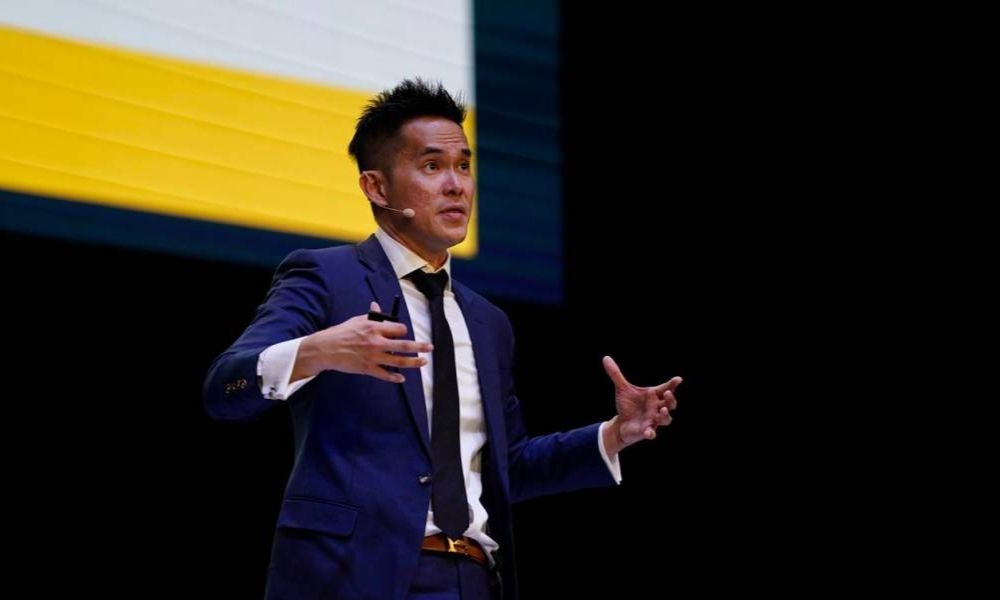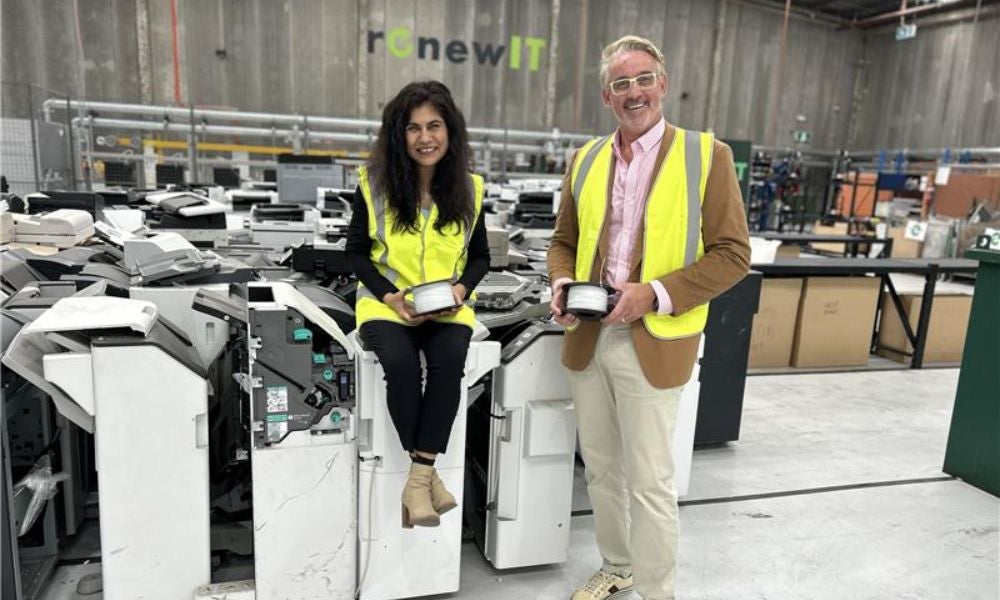From e-waste to innovation: The story of a circular economy entrepreneur
Download The Business Of podcast on your favourite podcast platform.
Renew IT's James Lancaster transforms e-waste into high-value filament using circular economy methods to reduce plastic waste and support sustainable manufacturing
Electronic waste is one of the fastest-growing and most complex waste streams in the world, and it poses significant environmental and economic challenges. According to the UN’s global E-waste Monitor, a record 62 million tonnes of e-waste were produced in 2022. This is up 82% from 2010 and on track to rise another 32% to 82 million tonnes in 2030. This 62 million tonnes of e-waste would be enough to fill 1.55 million 40-tonne trucks, roughly enough trucks to form a bumper-to-bumper line encircling the equator.
The same research found that only 22% of this e-waste was documented as having been properly collected and recycled, leaving US$62 billion worth of recoverable natural resources unaccounted for and increasing pollution risks to communities worldwide. E-waste is considered hazardous waste as it contains toxic materials which are known or suspected to cause harm to human health, and several are included in the 10 chemicals of public health concern, including dioxins, lead and mercury.
For Australian entrepreneur James Lancaster, this stark reality drove a business transformation that may offer part of the solution to our global plastic crisis. Mr Lancaster founded Renew IT in 2008, initially as a straightforward venture to make money by recycling corporate e-waste. What began as a purely profit-driven enterprise evolved into something more purposeful as Mr Lancaster confronted the scale of the e-waste problem firsthand.
“I didn’t start off as an evangelical environmentalist. I just started off as a guy who just wanted to make money for my family, but found myself somewhat being this environmental preacher, and trying to get people to do the right thing. And I guess that’s just evolved,” explained Mr Lancaster, who was recently interviewed by Dr Juliet Bourke, Adjunct Professor in the School of Management and Governance at UNSW Business School for The Business Of, a podcast from UNSW Business School.
The journey from e-waste recycling to advanced manufacturing
Renew IT began by collecting and refurbishing corporate laptops and other devices, wiping data securely and selling functional equipment to second markets. However, Mr Lancaster soon encountered a significant issue: many collected items, particularly office printers, had no resale value and began accumulating in warehouses.
This challenge led him to explore more innovative solutions. In 2018, he discovered research by Professor Veena Sahajwalla at UNSW Sydney on e-waste microfactories. Intrigued by the potential to break down e-waste components and repurpose materials, Mr Lancaster formed a partnership with UNSW that would transform his business model.
The result was world-first technology that converts e-waste plastic into 3D printer filament – a high-value material that can be used to create new products. This innovation provides a closed-loop solution for plastic that would otherwise end up in landfill, potentially creating harmful microplastics. “The biggest problem that we have in the world today is we’ve got 12 tonnes of plastic being manufactured every second globally, we’ve got 400 million tonnes of plastic waste going into the oceans and going into landfill. The byproduct of that is microplastics, which end up in us,” Mr Lancaster said.
Creating value through circular economy principles
The filament microfactory represents a practical example of circular economy principles in action. By transforming waste materials into valuable resources, Renew IT is tackling environmental challenges while creating new business opportunities.
In the podcast, Professor Barney Tan, Senior Deputy Dean for Impact and Partnerships at UNSW Business School, described the circular economy as “a consumption paradigm and an economic system aimed at eliminating waste and making the most of resources. Instead of the traditional take, make and dispose model, a circular economy emphasises reusing, remanufacturing and recycling products and materials to create a closed-loop system.”

The business case for this approach is compelling. According to Prof. Tan, circular practices often lead to significant cost savings, reduce raw material expenses, and the creation of new revenue streams from recycled products. “This model promotes financial sustainability by lowering long-term operational costs and mitigating risks related to resource scarcity,” he said.
Mr Lancaster’s technology allows high-quality ABS plastic from products like toner cartridges to be transformed into furniture, waste bins, and other useful items. “If we can convert that into tables, chairs, electrical clamps, wastepaper bins, other items that can be used, then we’re going to reduce the demand for virgin plastic,” Mr Lancaster explained.
Practical applications of e-waste technology in Australian markets
The potential market for recycled filament is substantial. Mr Lancaster noted that Australia’s nearly 10,000 schools likely have 3D printers that consume one or two spools of filament weekly – approximately 20,000 spools that could be supplied with recycled material rather than virgin plastic.
Renew IT has already begun supplying 3D-printed furniture parts for student accommodation, with an initial order for 600 wastepaper bins. Mr Lancaster envisions expanding these applications to create complete circular supply chains for major corporations.
Read more: From trash to treasure: recycling facility launched to give e-waste a new life
“If we just future gaze a little bit, there are telecommunications companies out there that have shop fronts in every high street. The vision there would be, quite simply, we could make all their furniture in their stores from their waste modems. So we could take all those old plastic modems, put them through the filament machine, and make nice tables and chairs for them. And they could be pointing to these tables and chairs and say that was made from a 4G modem,” Mr Lancaster said.
The company’s microfactory can produce approximately 35 one-kilogram spools of filament per hour. With growing demand, Mr Lancaster plans to expand operations across Australia before moving into international markets, particularly Southeast Asia, where demand for sustainable manufacturing solutions is increasing.
Beyond recycling: Building sovereign manufacturing capability
Mr Lancaster sees the technology as more than just an environmental solution – it represents an opportunity to rebuild Australia’s manufacturing sovereignty. The COVID-19 pandemic exposed vulnerabilities in global supply chains and dependence on overseas manufacturing.
"All of these activities are designed to stimulate manufacturing in Australia again. And that's the great thing about this, is it's a sovereign solution," Lancaster said. "We saw in covid how dependent we were on countries like China to produce things for us. We couldn't get the goods in time, there was a huge shortage in supply. If we can get the manufacturing back up and running again in our own country, then we're not going to have those sorts of problems in the future."

The company is also exploring other innovative e-waste technologies, including solutions for safely transporting swelling lithium batteries and extracting valuable metals and oxides from circuit boards and smartphones.
Practical steps for businesses seeking sustainable e-waste solutions
While large corporations can implement comprehensive sustainability programs, Mr Lancaster believes small businesses can also make meaningful contributions to reducing e-waste. His primary recommendation is establishing relationships with accredited Information Technology Asset Disposition (ITAD) organisations.
"Every business out there, small or large, should have a relationship with an ITAD,” he said. “Just make sure you can follow the downstream process. Ask questions about the downstream process. Not everything that you dispose of will be reused, so ask the questions – what happens to the printers that you're not going to sell? Can you give me some guarantees that that won't end up in landfill?"
He emphasised that proper e-waste management is not just environmentally responsible but potentially profitable. Many businesses leave money on the table by failing to recover value from outdated technology, particularly data centre equipment that can be refurbished or have components recovered.
Mr Lancaster is critical of carbon offsetting as a primary sustainability strategy, comparing it to "having a swear jar on the table... but 'Oops, we'll just put $1 in the jar, and, you know, we'll plant a tree, or we'll do something makes us feel good,’” he observed.
Subscribe to BusinessThink for the latest research, analysis and insights from UNSW Business School
Instead, he advocated for genuine behavioural change and better alignment between procurement and sustainability teams within organisations. "The procurement team are out there procuring products to use inside their company, purely driven by dollar, and ultimately because of that, they'll be receiving a product that is not doing its best work for the environment. Now, if the sustainability team were in line with the procurement team you're going to have a different outcome,” he said.
As consumers and investors increasingly demand genuine sustainability credentials, businesses that adopt circular economy principles can enhance their reputation while contributing to meaningful environmental solutions. Mr Lancaster points to fashion house Prada as an example of a company embracing circularity through its 're-nylon' products made from recycled materials.
For Australian businesses seeking to improve their environmental performance, Mr Lancaster's journey with Renew IT demonstrates that innovation, university partnerships, and a commitment to circularity can transform waste challenges into competitive advantages. As the e-waste problem continues to grow, circular economy solutions like Lancaster's filament microfactory offer a blueprint for creating value while reducing environmental harm.
